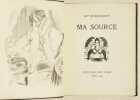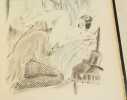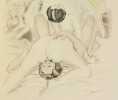MAUPASSANT (Guy de).
MA SOURCE.
1929 Paris, Éditions des Trois, 1929. Petit in-quarto (176 X 220 mm) veau noir, grand fer érotique doré sur le premier plat dans un ovale doré et une guirlande au palladium, dos lisse, auteur et titre dorés, date en queue, plats de la couverture conservés, étui bordé (Reliure moderne) ; (2) ff. blancs, (2) ff. de faux-titre et titre, frontispice, un fac-similé dépliant, (11) ff. de texte, 12 planches couleurs hors-texte, (2) ff. blancs, 40 planches de suite en noir.
Reference : 002349
ÉDITION ORIGINALE de ce curiosa publiée en 1929. Elle est ornée de 12 ILLUSTRATIONS LIBRES EN COULEURS et de 9 vignettes en noir (dont celle du feuillet de titre) du peintre, graveur et illustrateur français André COLLOT (1897-1976). Le fac-similé dépliant de l'autographe original figure en tête de l'ouvrage. Tirage limité à 150 EXEMPLAIRES (1 Japon nacré, 12 Japon Impérial, 50 Hollande et 87 Rives), celui-ci UN des 50 EXEMPLAIRES numérotés sur papier de Hollande (n°20), enrichi de 4 SUITES des illustrations : un état avec remarques (11/12 planches), un premier état en noir (11/12 planches), un état définif en noir (7/12 planches) et la suite des épreuves des cuivres barrés (11/12 planches). (Dutel, 1874 - Manque à Pia). BEL EXEMPLAIRE dans une RAVISSANTE RELIURE décorée. FINE COPY. PICTURES AND MORE DETAILS ON REQUEST.
Bookseller's contact details
Librairie ancienne & Moderne Eric Castéran
M. Eric Castéran
26, rue du Taur
31000 Toulouse
France
contact@librairie-casteran.com
06 21 78 12 79
Payment mode





Sale conditions
Conditions de vente conformes aux usages du Syndicat de la Librairie Ancienne et Moderne et de la de la Ligue Internationale des Libraires de livres Anciens (LILA). Les livres sont garantis complets et en bon état sauf mention contraire. L’envoi des ouvrages par la Poste est en sus. Un envoi prioritaire en recommandé est d’environ 8 euros pour la France, 15 euros pour l’Europe et 20 euros pour les USA. Ce tarif est basé sur celui d'un livre pesant 1 kilogramme. Si le livre commandé dépasse ce poids nous pouvons être amené à vous contacter pour vous signaler le prix du supplément de port. Terms of sale according to International League of Antiquarian Bookseller's rules. Books are guaranteed to be complete and in good condition unless otherwise stated. Postage at cost is extra. Priority and registred mail : about 8 Euros for France, 15 Euros for Europe, 20 Euros for USA. Shipping costs are based on books weighing 2. 2 LB, or 1 KG. If your book order is heavy or oversized, we may contact you to let you know extra shipping is required.
5 book(s) with the same title
Revue des Etudes Coopératives Mutualistes et Associatives, n° hors-série. Actes du Forum FMP La Source : Le soutien à domicile en Europe
Revue des Etudes Coopératives Mutualistes et Associatives Dos carré collé 1995 In-8 (16x24 cm), dos carré collé, 128 pages, n° hors-série de la Revue des Etudes Coopératives Mutualistes et Associatives, actes du Forum FMP La Source, 1er trimestre 1995, 74e année, ouvrage collectif ; plats à peine salis, très bon état. Livraison a domicile (La Poste) ou en Mondial Relay sur simple demande.
DIsque Vittel Grande Source - Mensurations et dentition de l'enfant
Vittel Disque "Disque publicitaire (17,7 x 16 cm) Vittel Grande Source ""L'eau de la première dent"", imprimé en couleurs, recto-verso, présentant les mensurations moyennes de l'enfant et la pousse des dents ; pliure dans un coins, quelques marques de frottement, assez bel état général. Livraison a domicile (La Poste) ou en Mondial Relay sur simple demande."
Lot de 3 ouvrages de Michel Tournier : La Goutte d'or - Eléazar ou la Source et le buisson - Des clefs et des serrures
Hachette, Chêne, NRF Gallimard Dos carré collé Trois volumes in-8 (14 x 20,5 et 15 x 21 cm), 2 dos carré collé et 1 broché, lot de 3 ouvrages de Michel Tournier : La Goutte d'or (Gallimard, 1986, 261 pp. ; quelques petites marques d'usage sur la couverture jaunie) - Eléazar ou la Source et le buisson (Gallimard, 1996, 139 pp. ; pliure au dos) - Des clefs et des serrures (Chêne/Hachette, 1979, 195 pp. ; pliure au dos, couverture partiellement décollée du corps d'ouvrage au dos, mais l'ensemble tient) ; assez bon état général. Livraison a domicile (La Poste) ou en Mondial Relay sur simple demande.
Source de joie - Clairière - Manitoba
J. Férenczi et fils, éditeurs Relié "In-8 (16 x 21,5 cm), reliure demi-toile, dos lisse, pièce de titre, couvertures conservées, trois ouvrages de Maurice Constantin-Weyer dans la collection ""Le livre moderne illustré"" reliés en un volume : ""Source de joie"" (1935, 187 pp.) ; ""Clairière"" (1935, 187 pp.) ; ""Manitoba"" (1930, 157 pp.) ; rousseurs au dernier ouvrage, par ailleurs bon état. Livraison a domicile (La Poste) ou en Mondial Relay sur simple demande."
Aven (complet en 3 volumes) T1 : Les Lois de l'attraction - T2 : L'affût - T3 : Source, je boirai de ton eau
Vents d'Ouest Album cartonné Trois volumes in-4 (22,7 x 29,7 cm), albums cartonnés, T1 : Les Lois de l'attraction (2005) - T2 : L'affût (2006) - T3 : Source, je boirai de ton eau (2007), le premier tome est dédicacé ; très bon état général. Livraison a domicile (La Poste) ou en Mondial Relay sur simple demande.
 Write to the booksellers
Write to the booksellers








